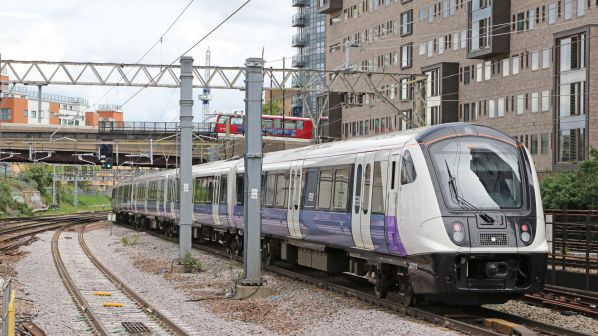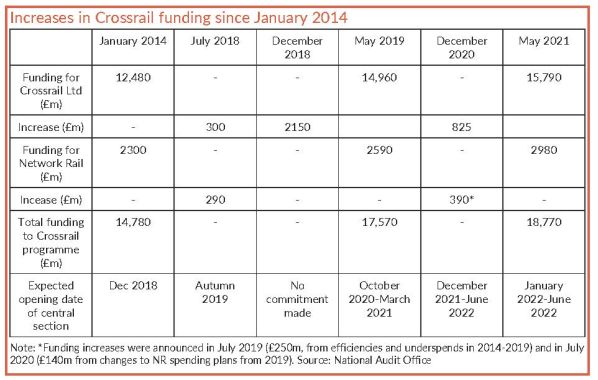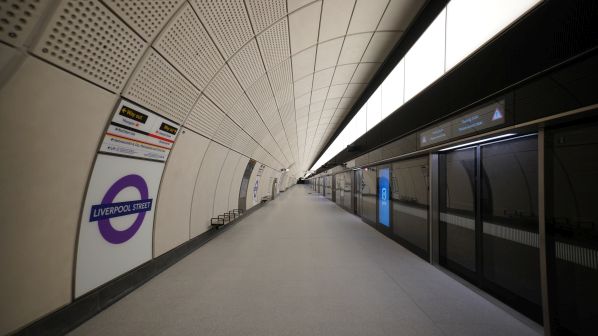MAINLINE trains carrying passengers should be travelling east-west on the new Elizabeth Line beneath central London right now. In fact, they should have begun doing so in December 2018, but instead while the trains are there, the passengers are not. Yet.
Crossrail Ltd announced that it would miss the December 9 2018 opening date for the 21km Abbey Wood - Paddington central section in late August 2018. The cause was simple: the need to complete the final infrastructure and carry out extensive testing, which is now underway.
A new management team, led by Mr Mark Wild, was appointed in November 2018 and tasked with completing the project. Once in place, Wild was clear that the project would finally be able to progress quickly because of the railway experience within the new team. He still believes that today.
“Nigel Holness came back from Sydney, so Australia have lost out there,” Wild says. “He’s running MTR’s concession. Howard Smith is chief operating officer, Jim Crawford is my programme director, Richard Schofield is in the mix with us in terms of infrastructure, so we’ve just got a great team.
“But having said that we’ve got to deliver the goods. And I think we’re on a good trajectory. We’ve done well, but there are a lot of challenges ahead for us. However, the biggest single challenge is the Siemens software because the quality of the software we have at the moment is good enough for trial running, but it’s not quite good enough for customers.”
“I think there’s ever increasing confidence that we’ll get earlier in the window rather than later.”
Mark Wild, CEO Crossrail Ltd
When Wild took over, trains were running in the new tunnel beneath London, but these were part of very initial testing. Now, in the latest update to Transport for London (TfL) on July 15, Wild explained that on May 10 four trains per hour (tph) began running on the central section, and this doubled to eight tph from June 7. He says these activities are helping build driver competence and route knowledge as well as for staff in the Route Control Centre.
Following the completion of an 18-day engineering blockade in mid-July, the final such event before the tunnel opens to passengers, trial running has increased to 12 tph, thereby replicating the initial service when passenger trains finally enter service. Timetable demonstrations of the eventual 24 tph service will also be carried out. Eventually, Wild told TfL, once trial running is completed then trial operation will begin. At this stage, staff and volunteers will make sure that all systems and procedures work efficiently. Every scenario imaginable will be tested from train and station evacuation to what happens if a passenger spills coffee inside one of the trains.
Crossrail facts and figures
- 41 stations on the route, 10 are new
- 42km of new tunnels
- 118km of railway from Reading/Heathrow Airport - Shenfield/Abbey Wood
- 500,000 estimated number of individual assets needs for the new railway, such as platform screen doors.
Wild explains the processes needed to reach these stages. “In December last year we did something called a system integration turnover test, which was six weeks of very, very intense testing in the Core where we found a lot about the software,” he says. That has enabled Crossrail to prove the safety of the new railway allowing trial running to begin. And that appears to be going well.
“The good news of trial running is so far we’ve had thousands of transitions [between Crossrail and Network Rail infrastructure] at the eastern and the western end, and they’ve been very reliable.”
One question that remains is the status of Bond Street station. So far five of the new stations have been handed over to TfL, but construction of Bond Street started 18 months later and so has always been running behind.
“We want to get to something called SE2 stage completion, which is the ability to evacuate passengers,” Wild says. “They [contractors] have to get there by August/September - they are on track for that. Again, we’ve decoupled it from the whole programme for the team and they have given it a good go, I mean, it won’t be much later than the first quarter of next year. If we open at the back end of our opening window which is the first half of next year, then Bond Street is going to be in it. If we get really on the front edge then it’s likely Bond Street won’t be, but it’ll only be a month or two after.”
Before trial operation can begin, the ELR 100 software release must take place. This is the train and signalling software that will be used for the passenger service.
Wild tells IRJ the thinking behind the planned integration of this software. “It’s the baseline customer software that everything else will grow from,” he says. “The good news is that Siemens has finished the software and they’re now doing the application engineering. We’re just going to pick the sweet spot of when to drop that into the real world. That’s important because once that goes into the railway, it’s the final step before we enter trial operation. Dropping ELR 100 into the railway is one of the most crucial things and right now we’re calculating the exact sweet spot to do so in the late-summer or autumn.”

Planning this is crucial. ELR 100 is expected to be released after the successful completion of timetable demonstrations so that only minor tweaks are required, but it must be done before trial operation begins. Wild says his team is very confident about the process, but the timing remains crucial as other tests are also needed, including the final integration testing that can only be completed using a class 345 Aventra EMU.
When IRJ spoke to Wild in mid-June, there was growing optimism around when passenger services could start in the core section. He did not commit to a specific date, but papers released by TfL in early July suggest February 2022 is when trains could begin carrying passengers between Abbey Wood and Paddington.
More significantly, the papers also suggest that the planned May 2023 opening date for the full Shenfield/Abbey Wood - Heathrow Airport/Reading route is set to be brought forward by six months.
Regarding the opening, IRJ asks if it is possible that trains could operate in revenue-earning service through the central tunnel this year? Wild remains non-committal.
“It’s difficult,” he says. “I think there’s ever increasing confidence that we’ll get earlier in the window rather than later. The problem with really pushing too hard to get things this year is that you can end up making a mistake by taking a shortcut, not a safety shortcut, but a programmatic shortcut that would lead you to a longer problem. So really you want the most stable stage three that you can possibly get as early as you can get.”
Britain’s largest infrastructure project
THE new railway is one of the largest civil infrastructure projects undertaken in Britain in many years. It consists of building 42km of new tunnels and fitting them with track, 25kV ac overhead electrification, drainage, ventilation systems as well as cabling and equipment required to support signalling systems.
10 new stations, some up to nine-storeys deep, have been built of which eight are underground. These are larger than most existing London Underground stations and have interchanges with other TfL stations and lines.
There is also work to integrate the new railway with existing Network Rail infrastructure and modernising stations on the conventional railway to meet the standards required.
Additionally, a fleet of 70 nine-car class 345 EMUs, each with capacity for 1500 passengers, are being tested, commissioned and introduced on various Crossrail routes.
Trains are already running on parts of the network. MTR began operating London Liverpool Street - Shenfield services under a concession that began in May 2015. The class 345 EMUs built by Bombardier were introduced in June 2017 although these had to run as seven-car trains rather than nine-car sets due to limitations caused by infrastructure.
On the western side of the network, nine-car class 345s run from London Paddington’s main station to Hayes & Harlington, Heathrow Airport and Reading. The class 345s were introduced onto services to Heathrow Terminal 5 more than two years late due to issues with the infrastructure and signalling, specifically ETCS Level 2, which is fitted to the branch from Airport Junction to Heathrow Airport and is now in place on the mainline to Paddington. Integrating this with the existing systems on the Great Western Main Line, as well as the EMUs themselves, took longer than anticipated, resulting in the lengthy delays.
There have also been major strides in engineering as well. “Full length trains into Heathrow, full length trains to Reading, and full-length trains into Liverpool Street High Level - they’re massive engineering achievements,” Wild says. The introduction of nine-car trains on the eastern section is also beginning although several intermediate class 345 cars remain in storage at Worksop, Nottinghamshire, waiting to be inserted into the shorter trains. Until that happens, some class 315 EMUs that date from 1980 remain in traffic.
Finance
There is no escaping the fact that Crossrail’s severe delays have caused financial problems for TfL. The loss of predicted revenue has been a factor. However, the plan to bring forward the introduction of trains on the full route could partially reset some of that.
Nevertheless, costs have continued to rise. Crossrail Ltd is believed to have paused construction for nine weeks from March 24 2020 due to the Covid-19 pandemic according to a National Audit Office (NAO) report published on July 9.
Crossrail Ltd also estimates that £228m of the £1.5bn increase in costs since April 2019 is down to social distancing and other Covid-19 factors.
The current funding package is £18.8bn, which represents a 28% increase on the £14.8bn budget announced in 2010. The current forecast to complete the project, according to Crossrail Ltd, is £18.9bn. While that does include Network Rail costs, it does not include the class 345 fleet or the new depot at Old Oak Common, which were both funded by TfL.
The current cost estimate for completing the project is between £30m and £218m according to the NAO report. There are estimates that the existing funding package will run out between July and September 2022. It has been agreed that some works can be carried out once the railway is open, while there is currently a review of other tasks that require completion to see if there are better ways of doing so.

“Financially, we were kind of within TfL but we’re still dual-sponsored by both the government and TfL so we’re kind of kept separate,” Wild says. “But we know the responsibility - we have to keep the bill down. We said we needed the extra £1.1bn and that is still a valid assumption with the opening window of the first half of next year, but only £825m was allocated. We’re living within that at the moment, and we’ve got to try our very best to keep within that, but it depends on when the railway opens.”
Nevertheless, Wild remains bullish over the financial benefits that Crossrail will bring, highlighting that the business case estimates benefits of £42bn. “Obviously our costs have gone up, but not in the context of £42bn, so in the long run you would expect Crossrail to meet its expectations,” he says.
That business case was created before Covid-19. The pandemic is expected to have a massive impact on the way people and companies work in the future and the new railway will serve the very heart of the City of London at Canary Wharf. Surely that could have an adverse effect?

“In the short-term there’ll undoubtedly be changes of travel patterns,” Wild admits. “But Crossrail has a 120-year minimum design life. Nobody knows today, but my personal view is that people will return.”
With the prospect of passengers travelling through the central tunnel in February 2022, it is worth standing back and taking stock of the project. Wild and his team inherited something of a poisoned chalice and one that London was incredibly focused on.
Crossrail’s problems have created concern, undoubtedly, around Britain’s ability to deliver future mega projects such as HS2. Wild tells IRJ that the two organisations meet regularly to discuss what has been learned. He also reveals that other teams from across the world have reached out for advice.
Still, what has Wild learnt since taking over in 2018?
Firstly, he says system integration has been “very, very complex” to complete the job. “We could have put a lot more effort into modularity, or we could have done a lot more factory testing, bringing modules to site,” Wild says.
Secondly, Wild says planning to an undefined end date created a great deal of uncertainty. He adds there should be honesty about uncertainty and to use planning windows rather than defined dates. “Crossrail stuck to December 9 2018 and I think that drove a lot of very unhelpful behaviours in the supply chain and the client,” Wild says.
The third is to get the right team for the right phase. He says the project has ended up in a positive position because it has a first-class integration team, but this was only built when Crossrail got into trouble.
Finally, he says it is important to build the programme around the rolling stock. “The class 345 is the most advanced machine - all the brains are on the train,” Wild says. “If you can base your infrastructure around the train, you’re not going too far wrong. On Crossrail we did the opposite. We built the infrastructure and then tried to graft the train into it.”

